
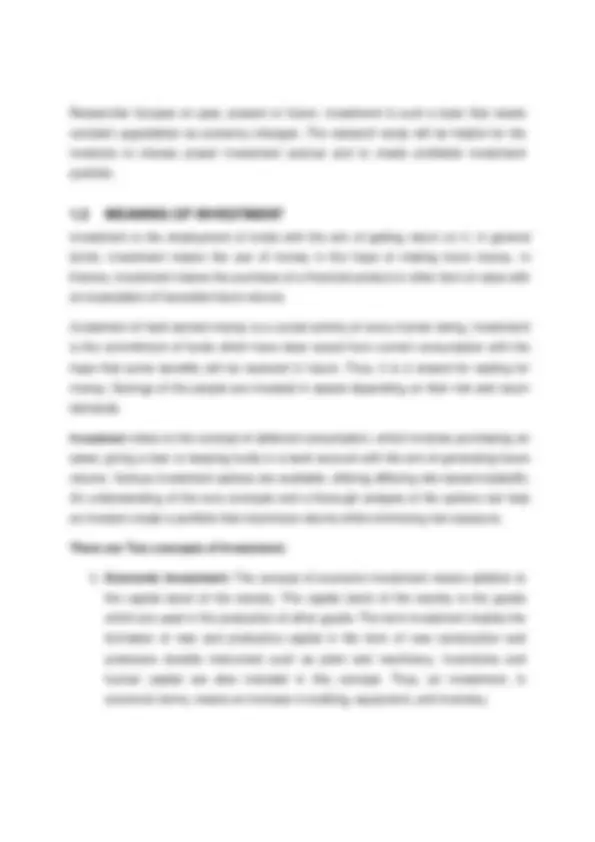
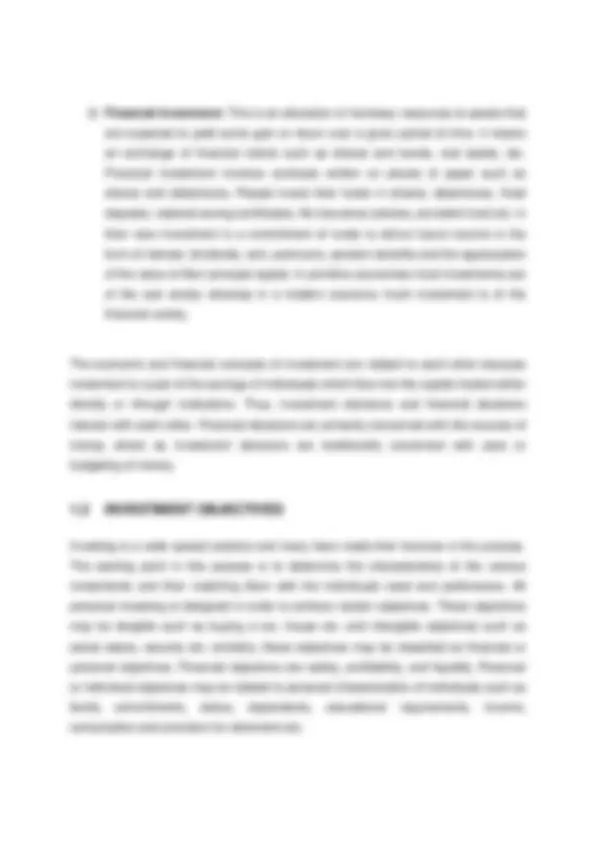
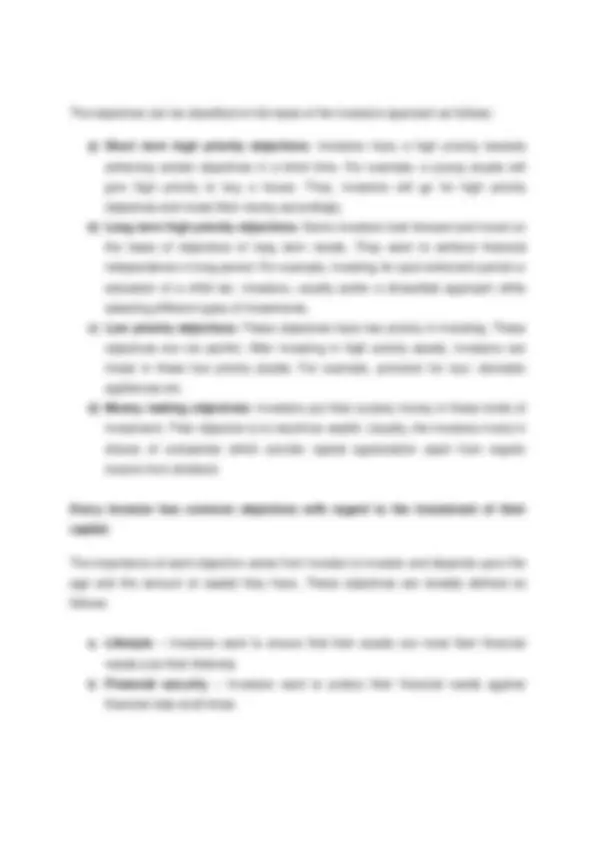
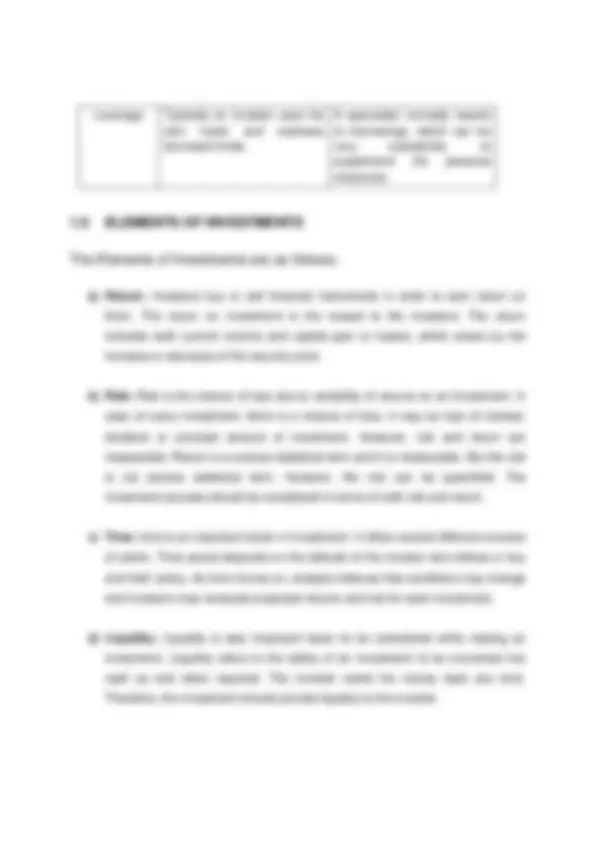
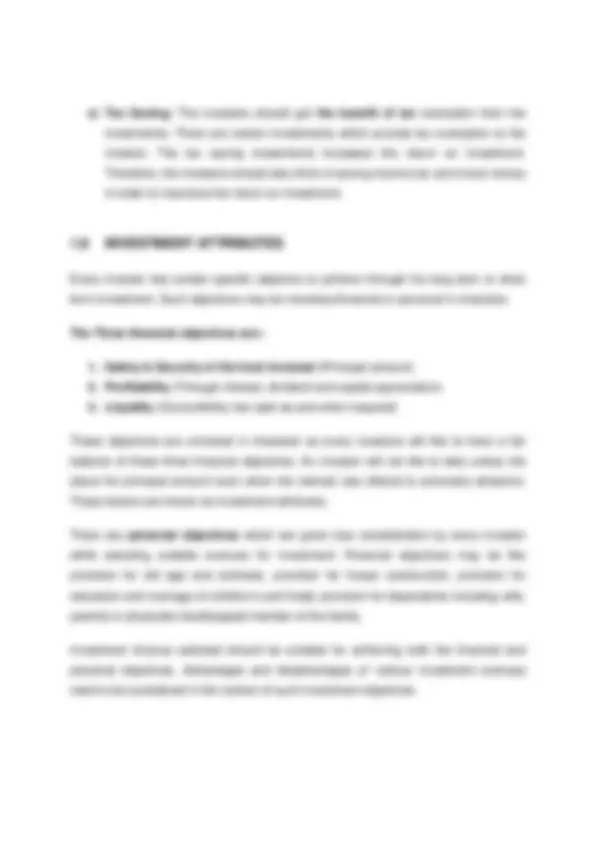
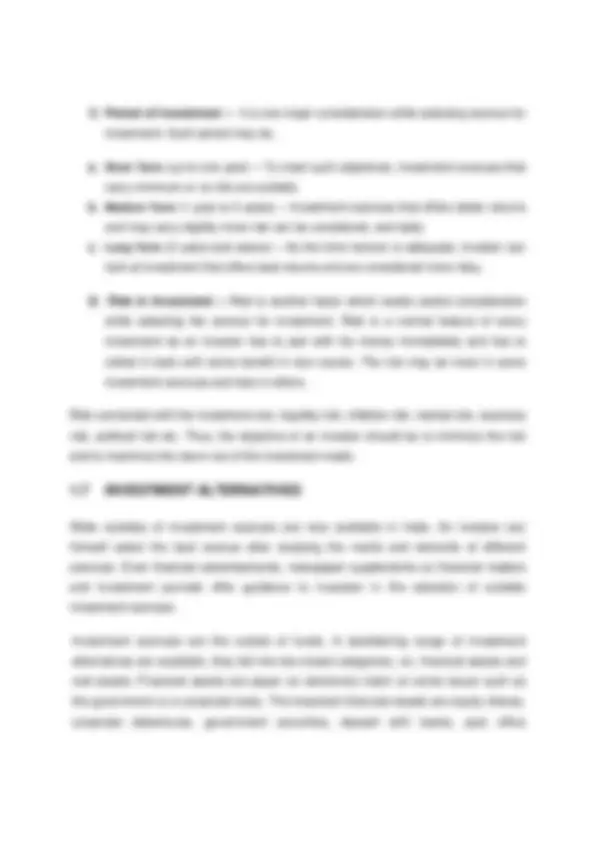
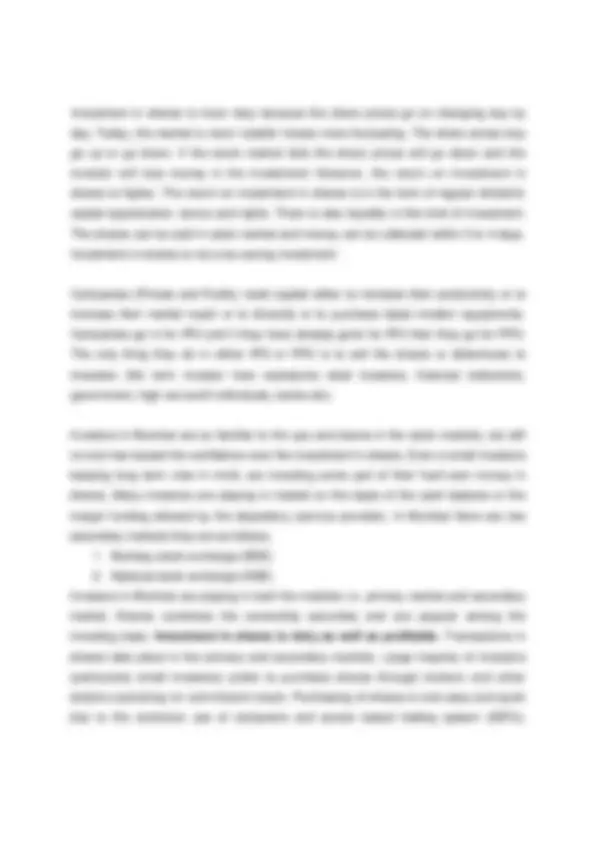
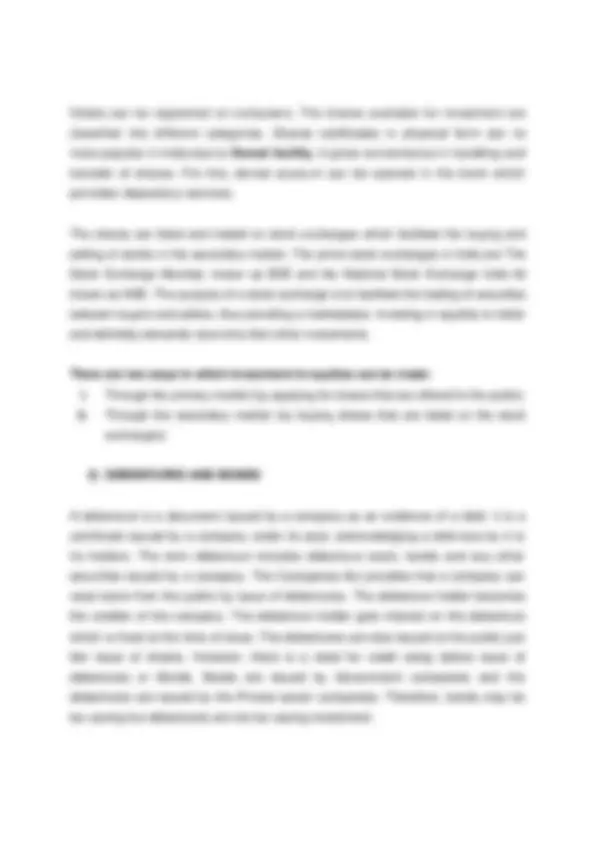
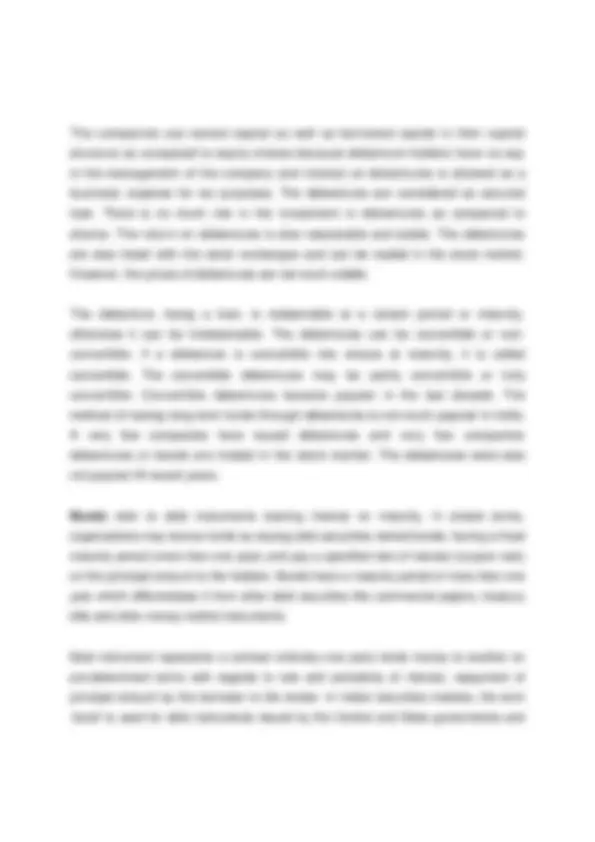
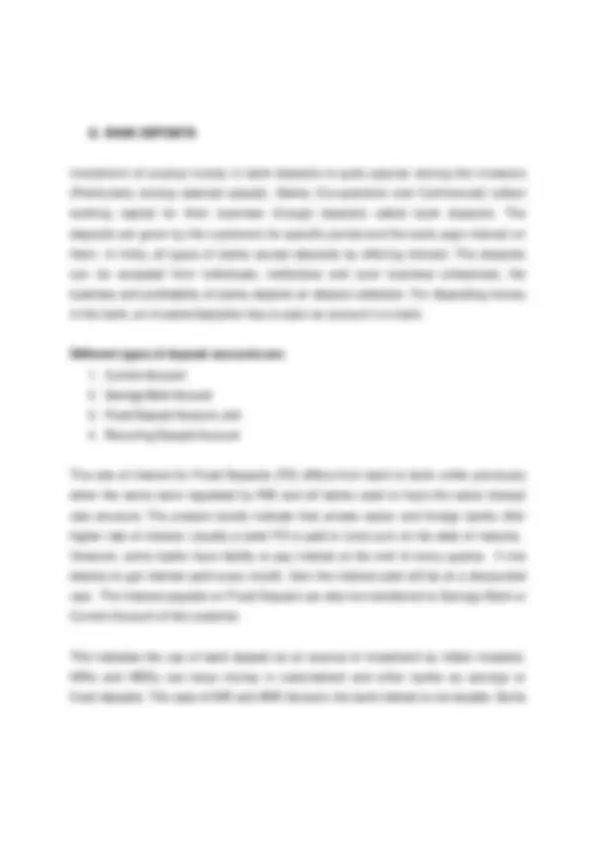
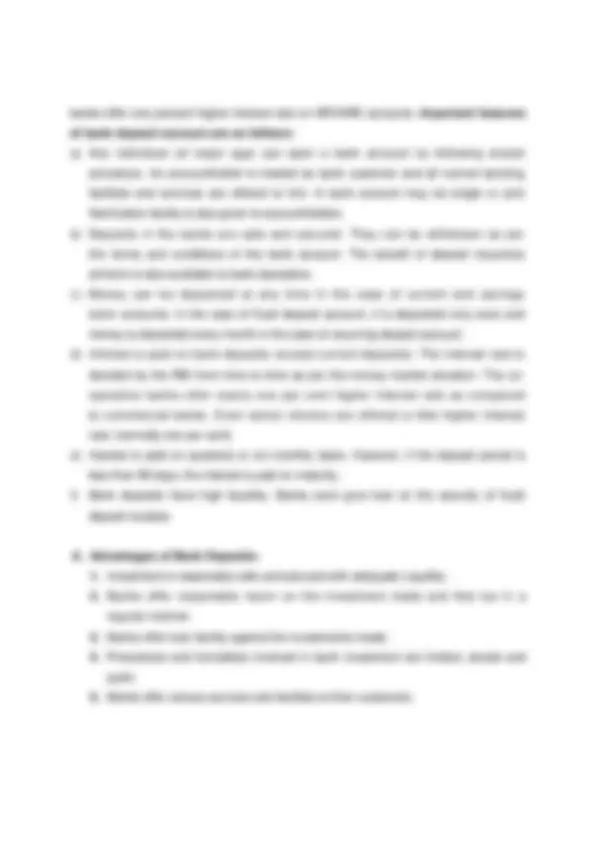
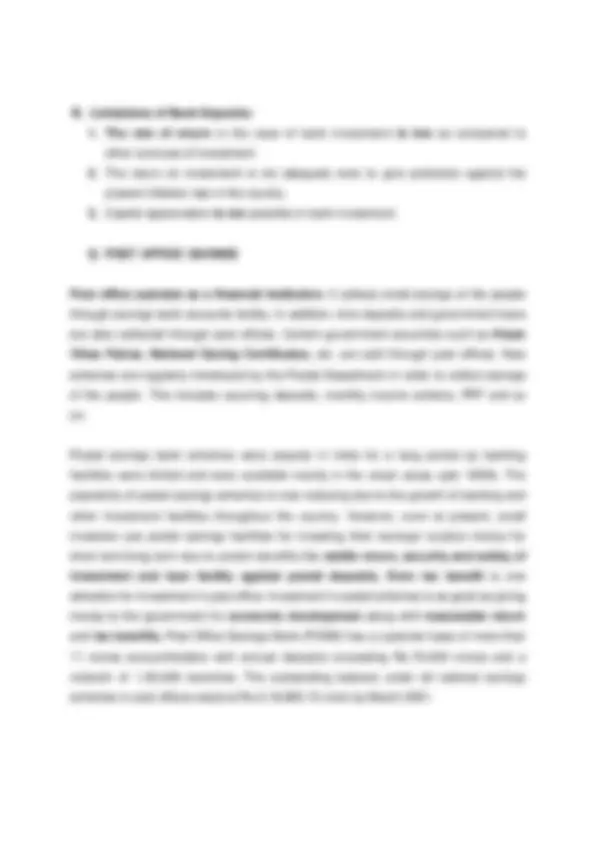
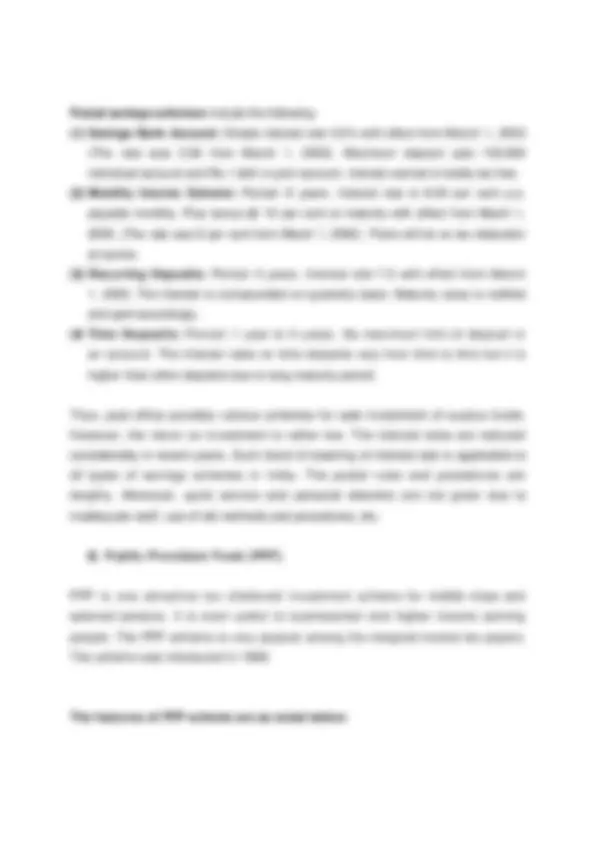

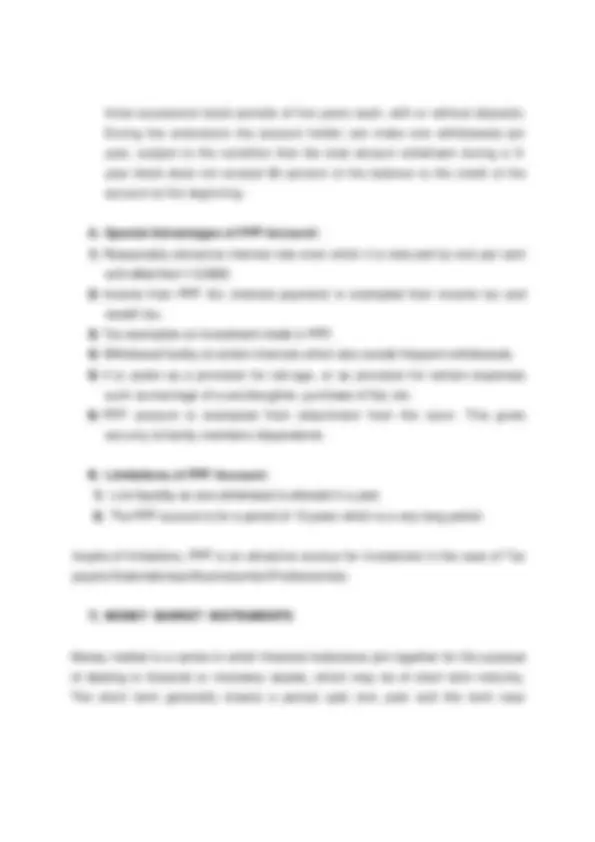


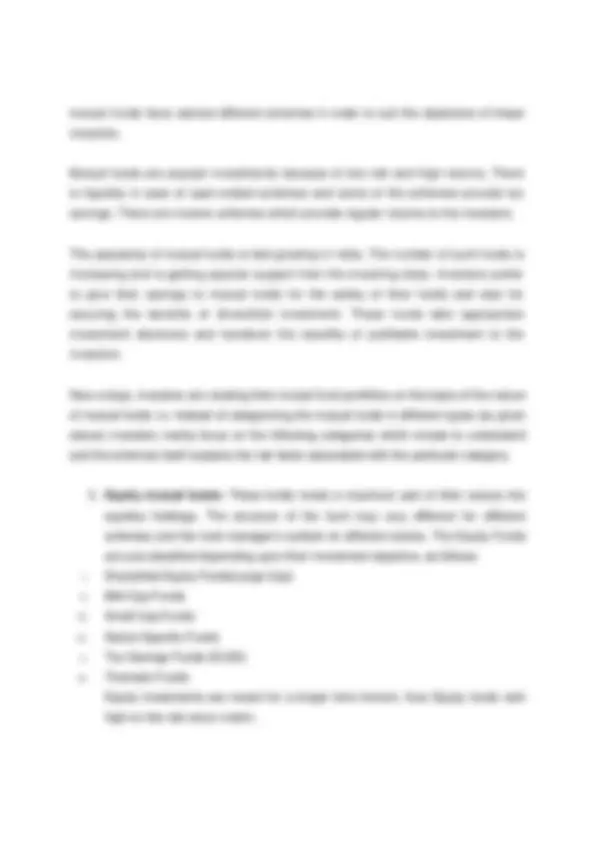
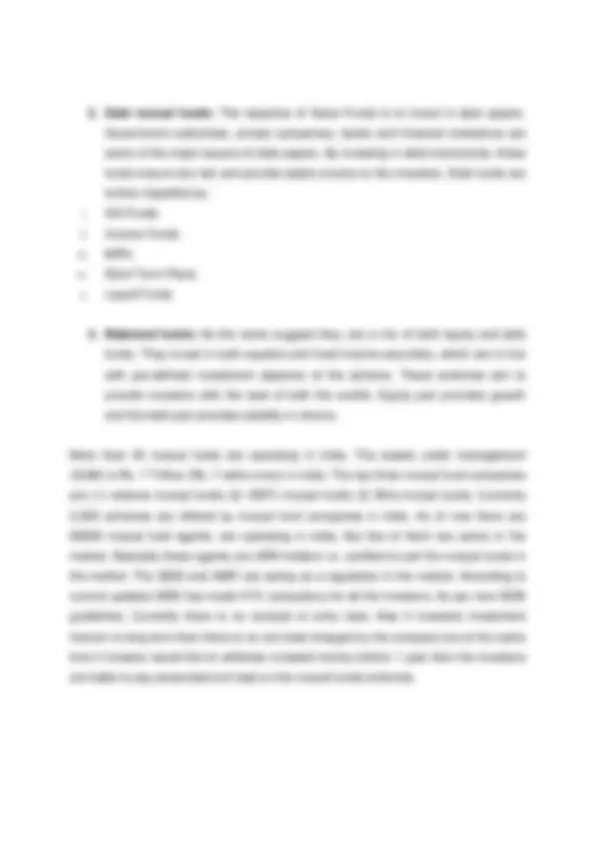
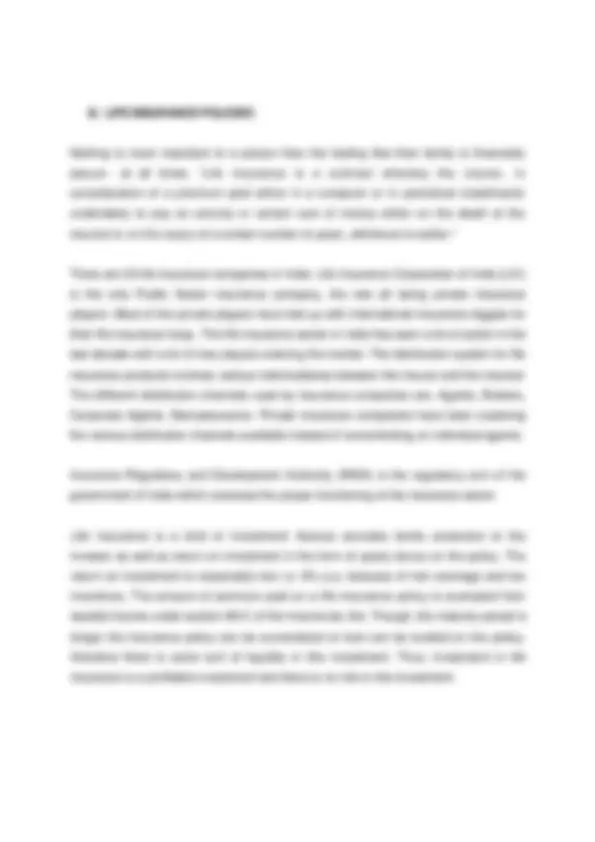
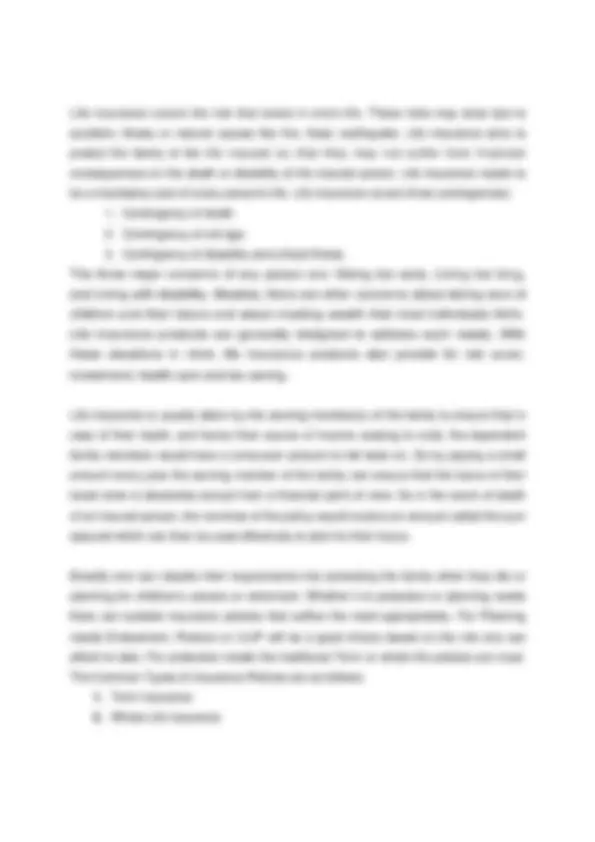
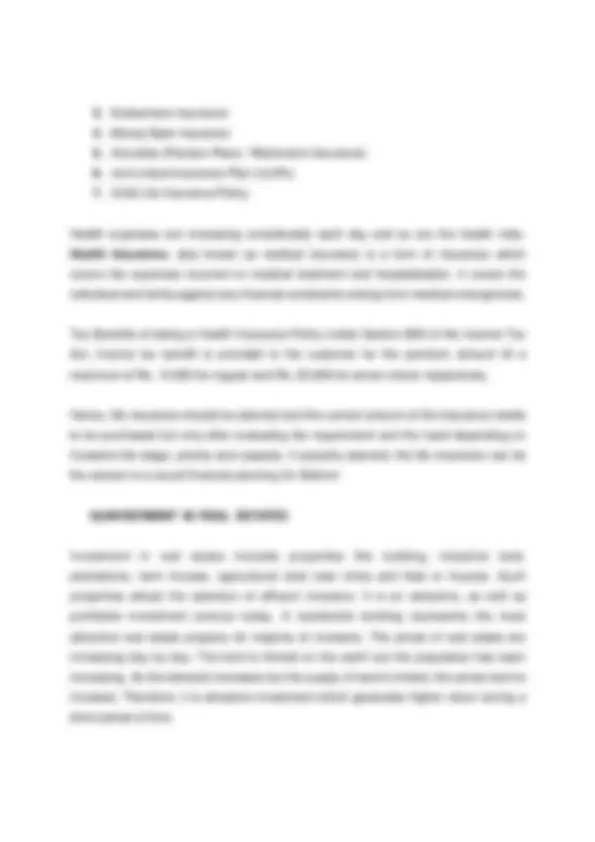

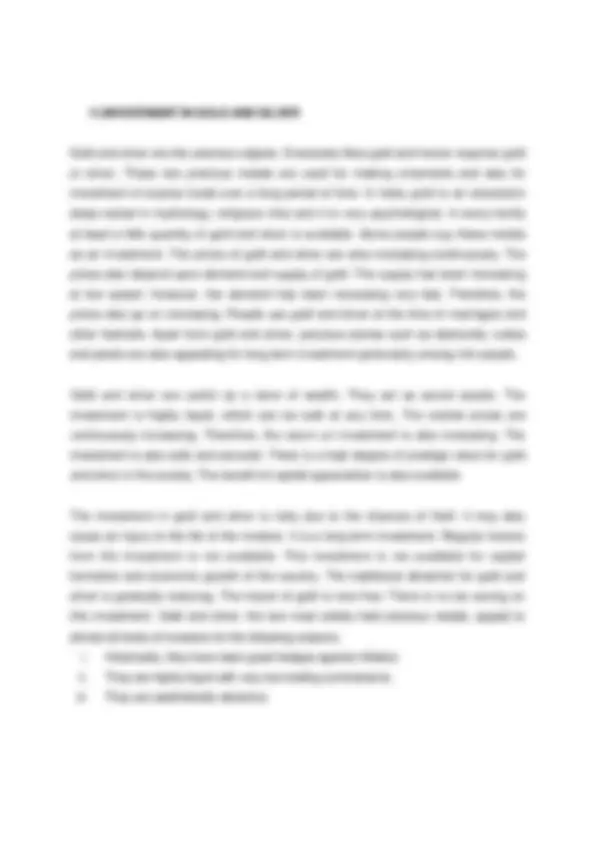
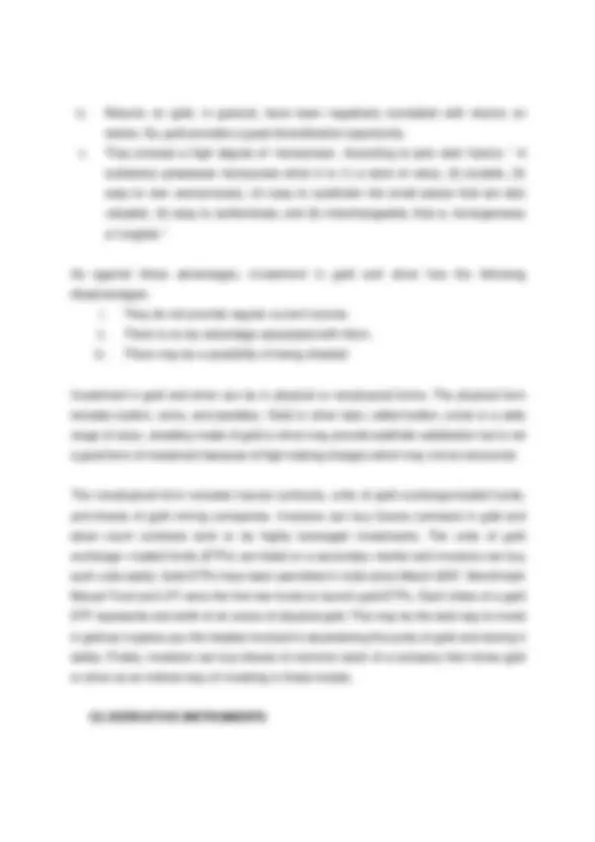

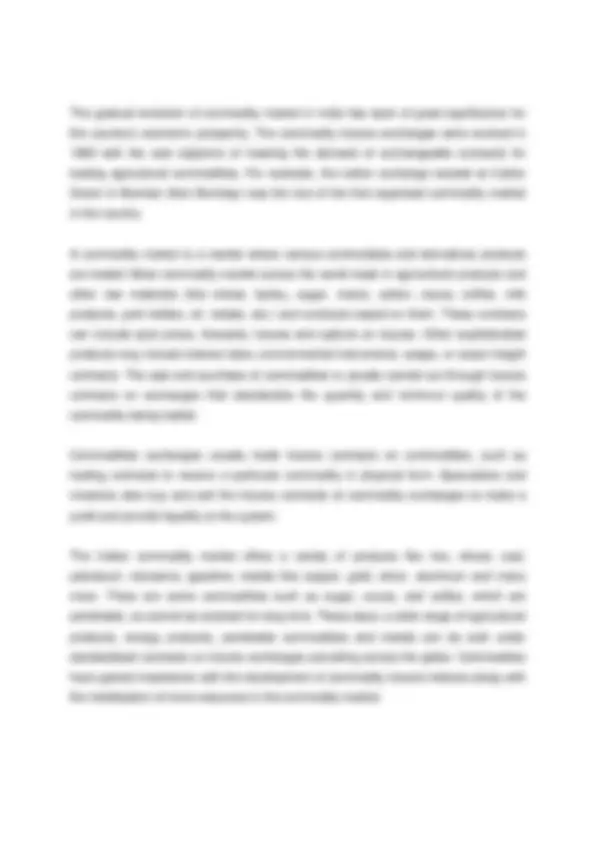

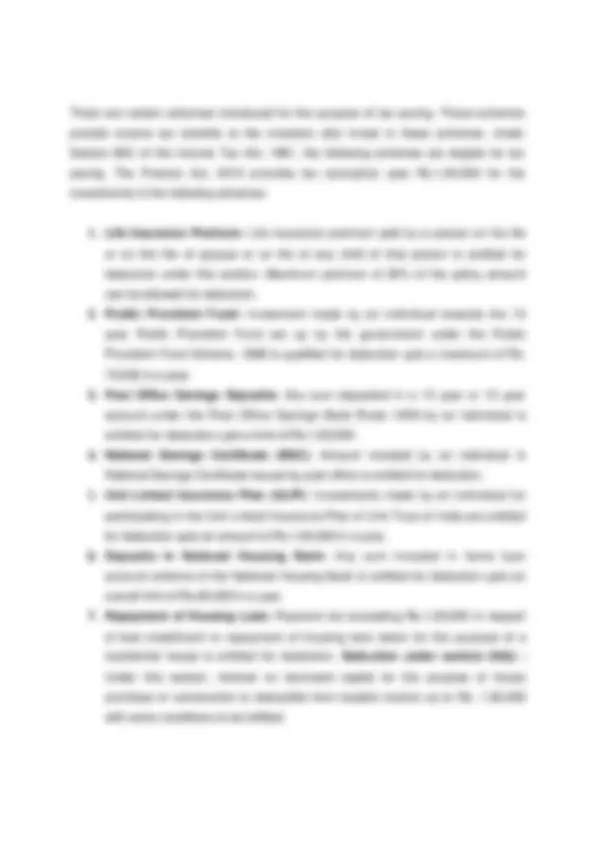
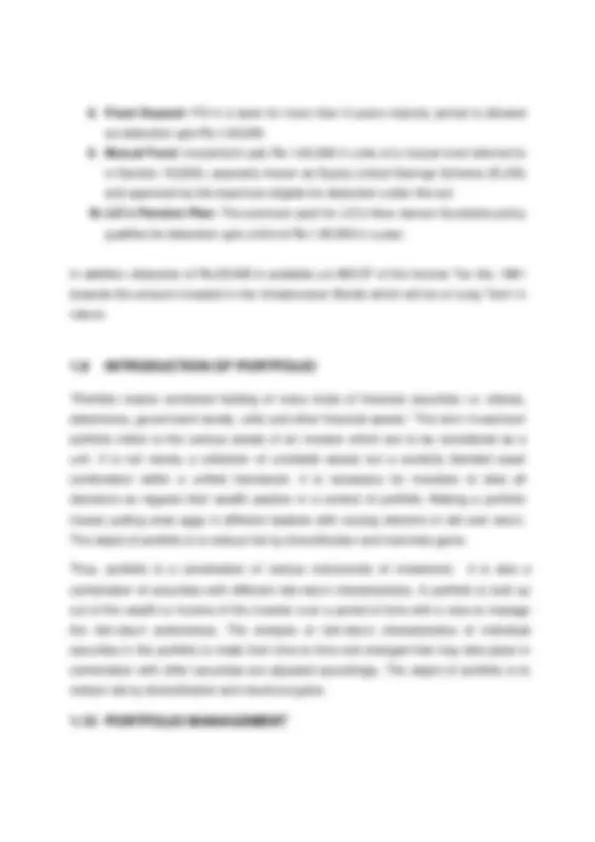
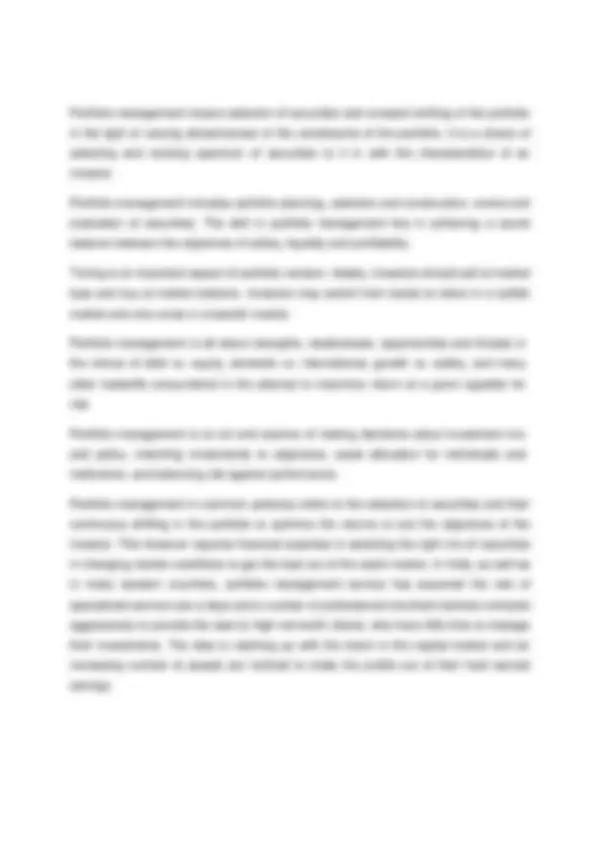
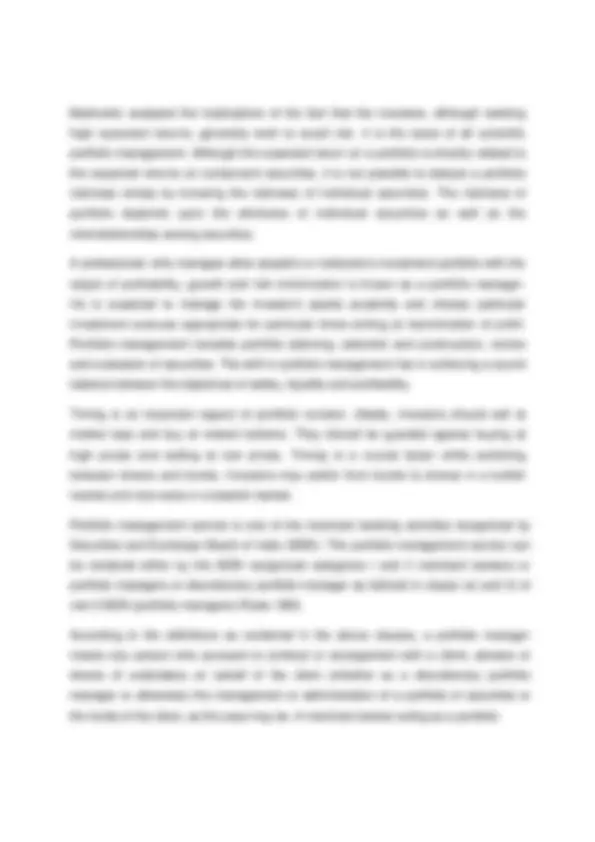
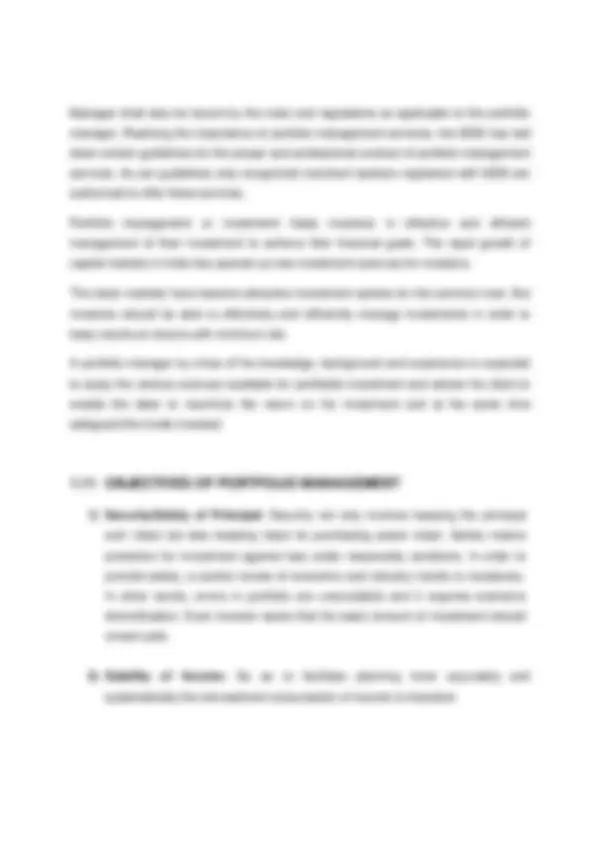
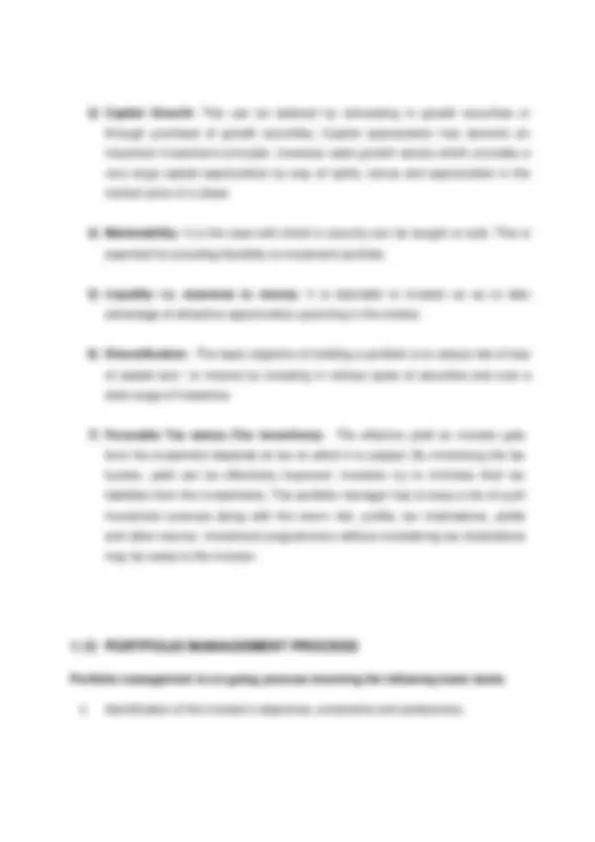
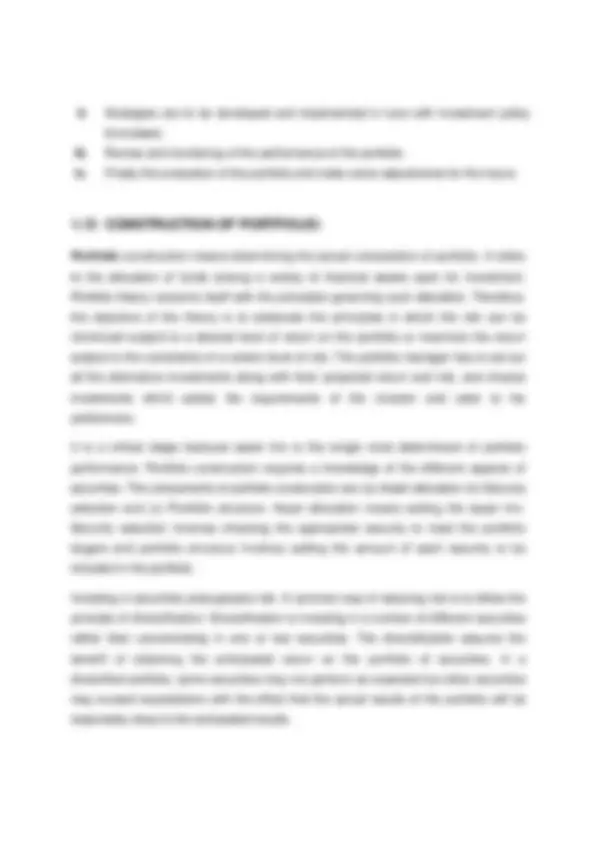
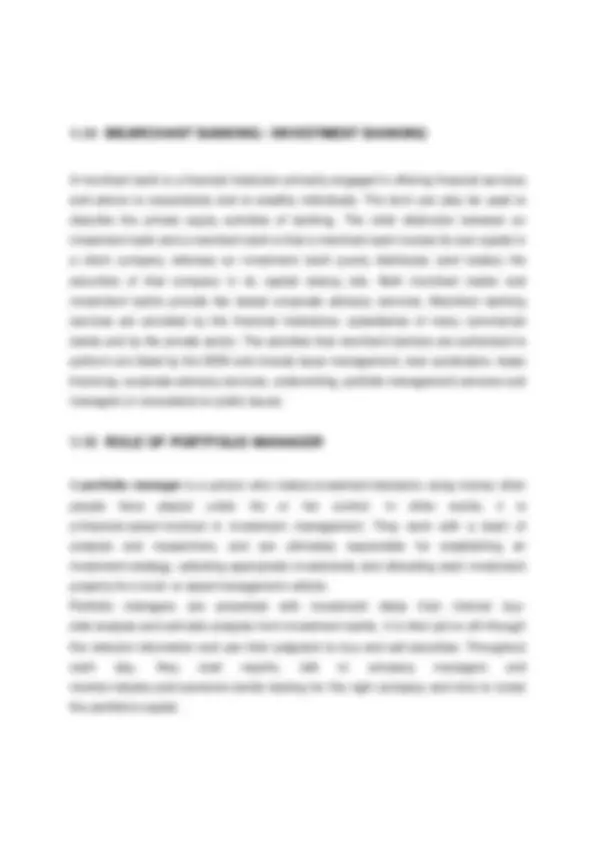

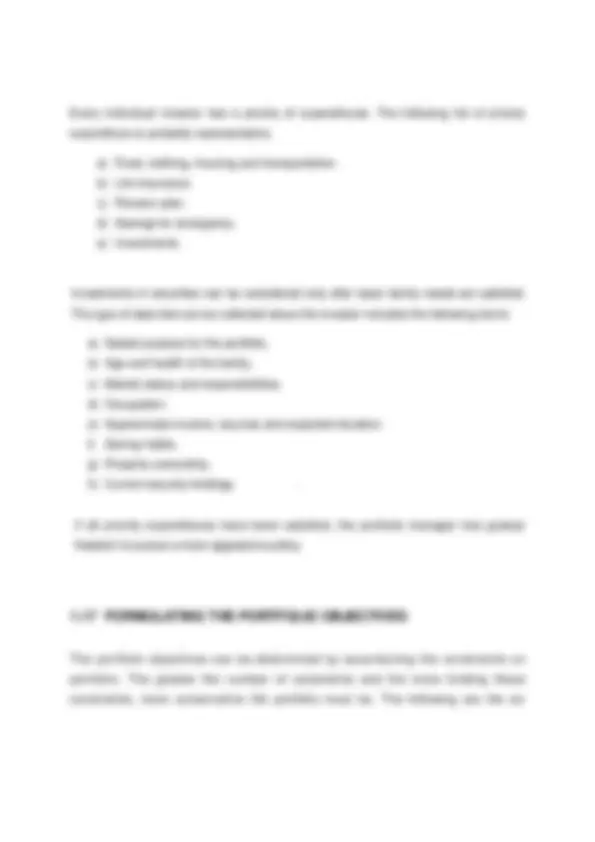
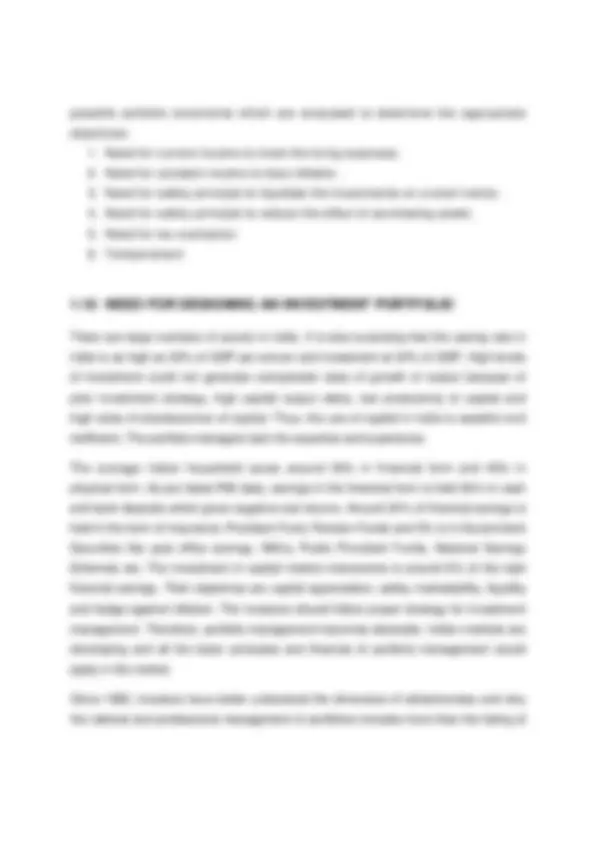
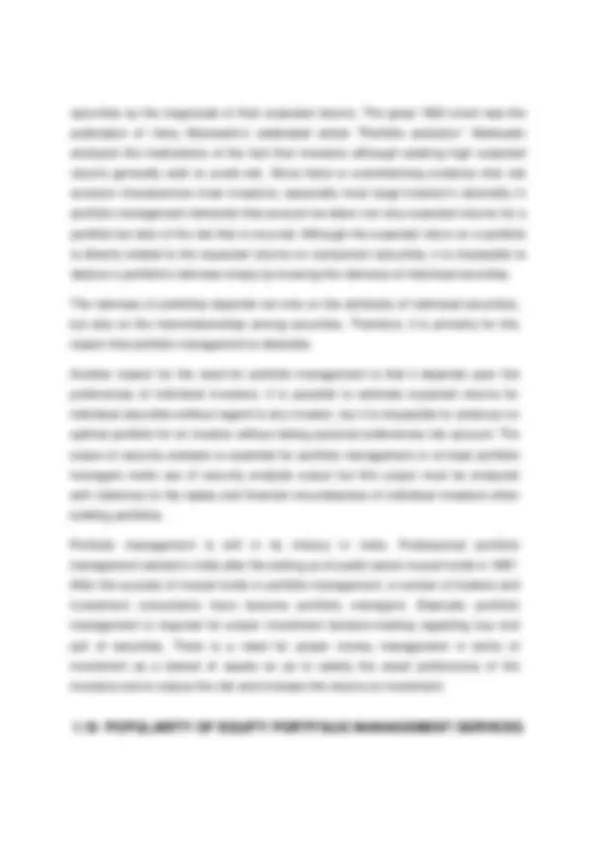
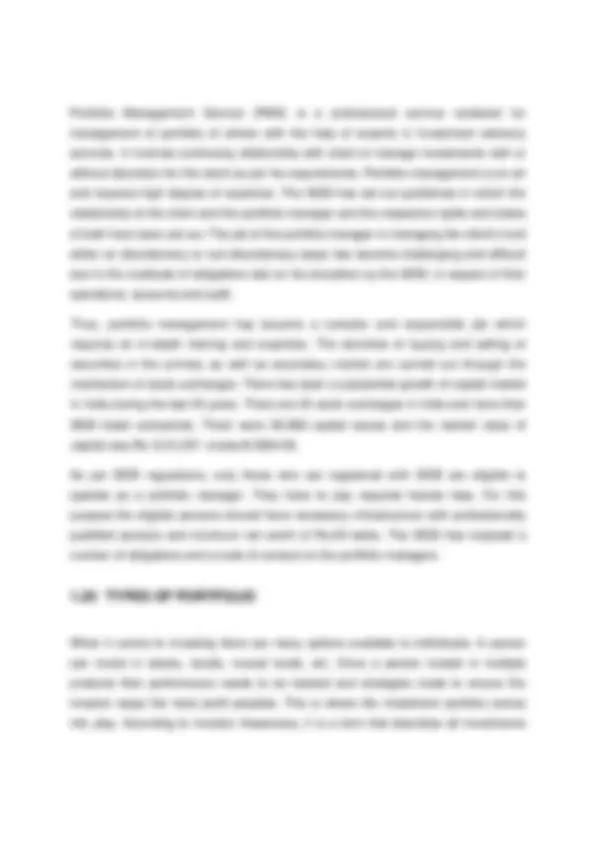
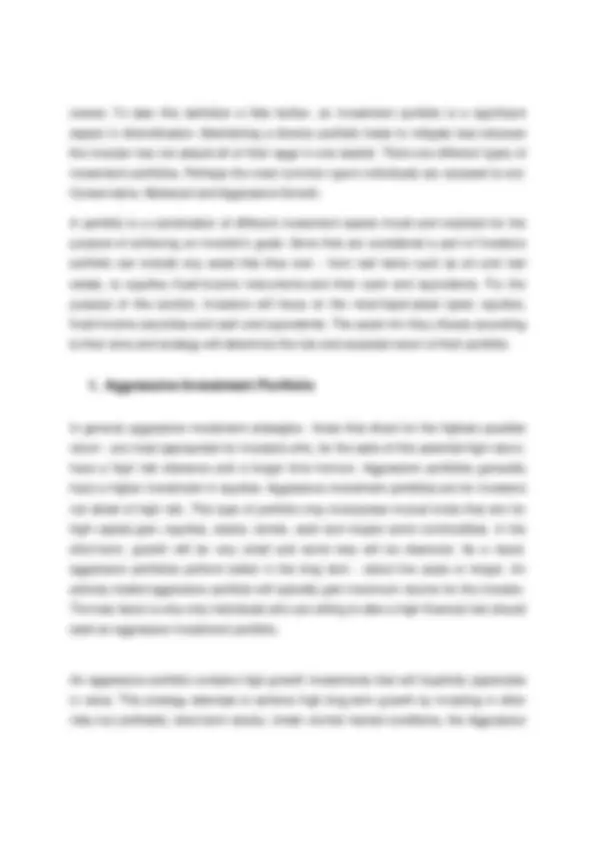


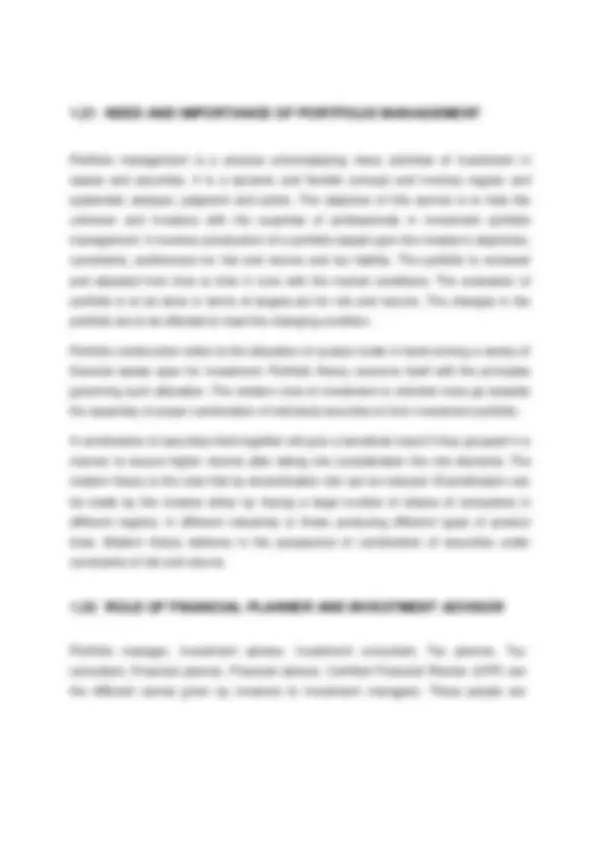
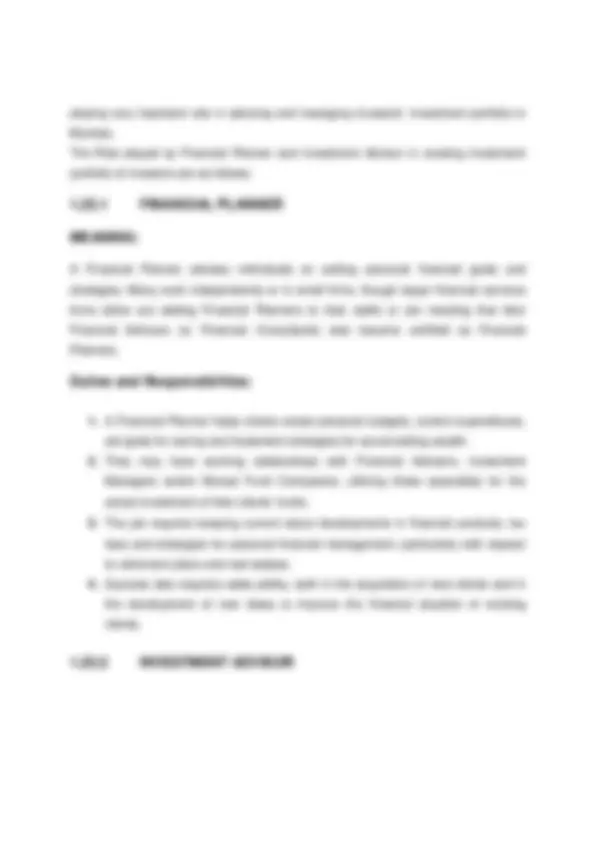
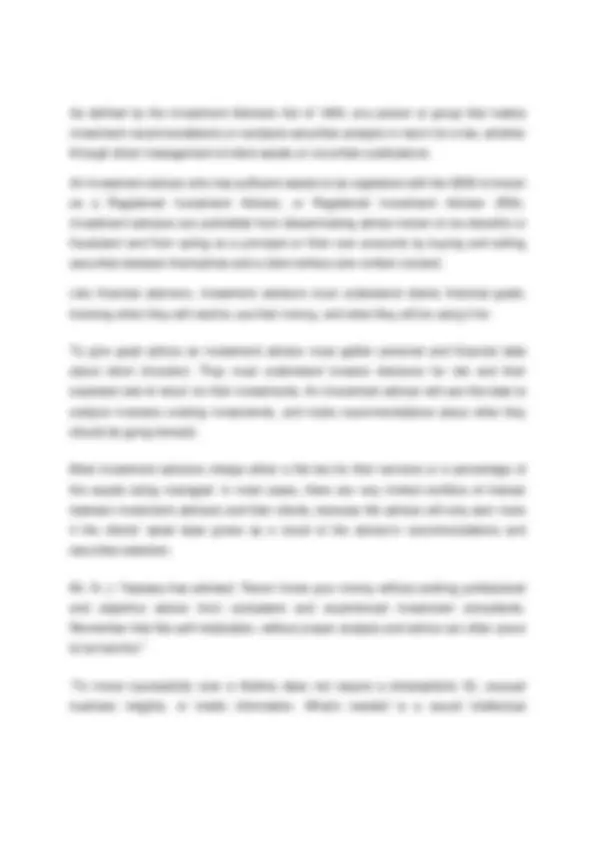
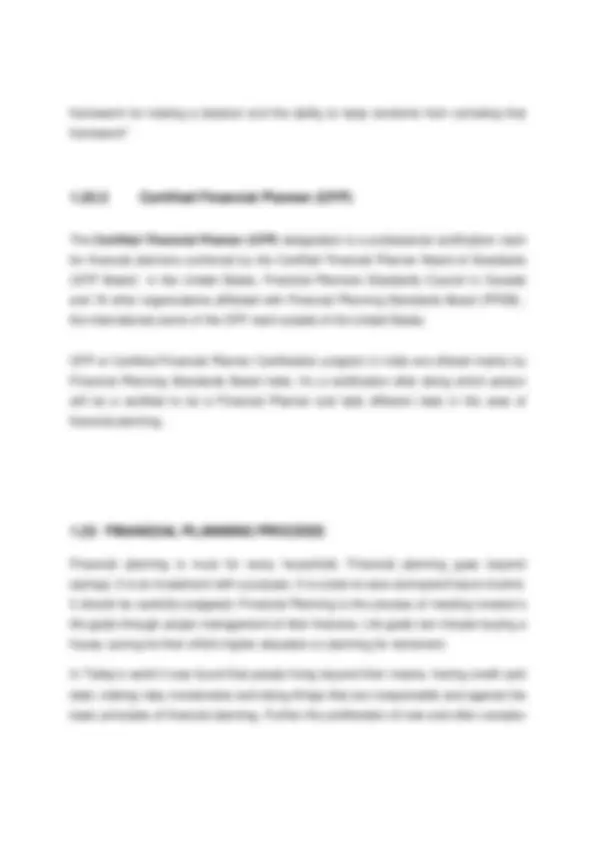

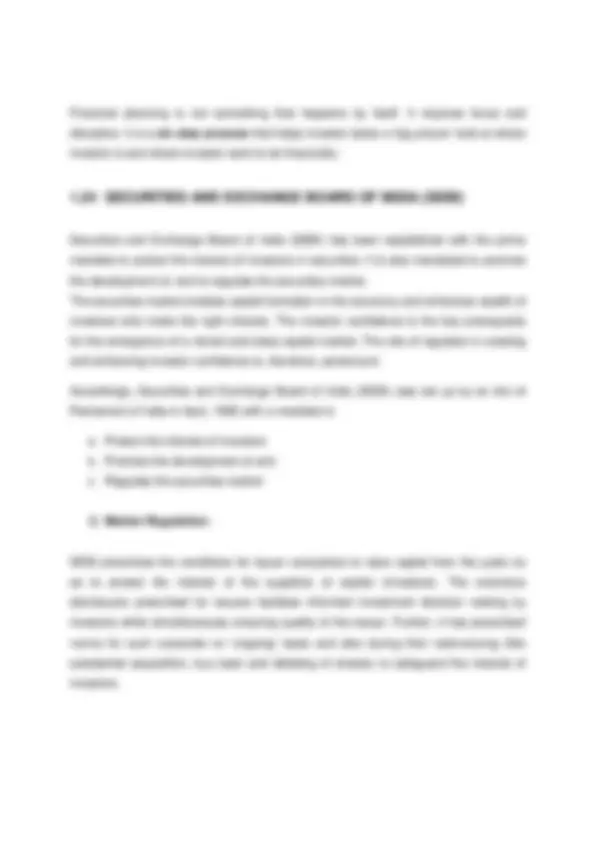
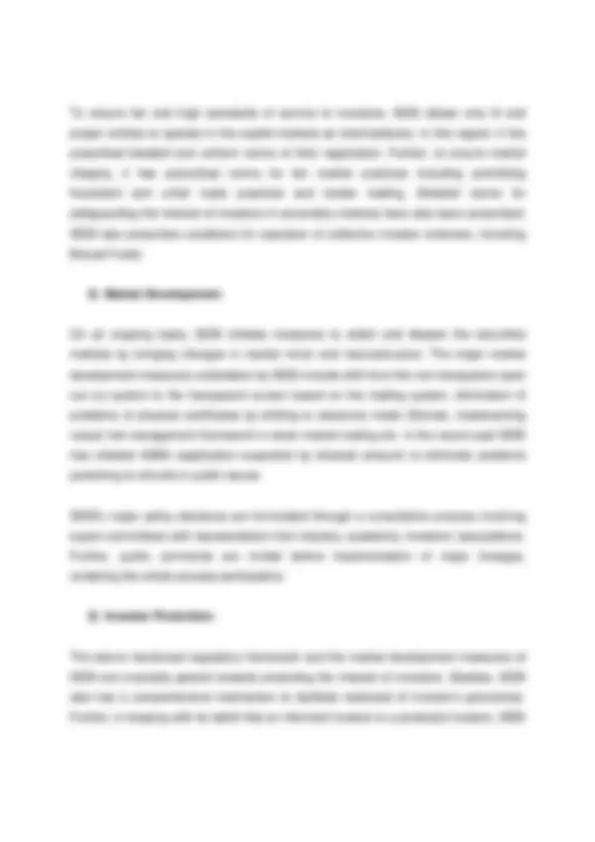



Study with the several resources on Docsity

Earn points by helping other students or get them with a premium plan


Prepare for your exams
Study with the several resources on Docsity

Earn points to download
Earn points by helping other students or get them with a premium plan
Community
Ask the community for help and clear up your study doubts
Discover the best universities in your country according to Docsity users
Free resources
Download our free guides on studying techniques, anxiety management strategies, and thesis advice from Docsity tutors
An introduction to investments and portfolio management. It explains why people invest and what they want from their investments. It also discusses different types of investment objectives and the difference between investment and speculation. The document emphasizes investments by individual investors and provides a definition of individual investors. It also explains the importance of managing assets and financial needs centrally to achieve investment objectives.
Typology: Essays (university)
1 / 60

This page cannot be seen from the preview
Don't miss anything!





















































For most of the investors throughout their life, they will be earning and spending money. Rarely, investor’s current money income exactly balances with their consumption desires. Sometimes, investors may have more money than they want to spend; at other times, they may want to purchase more than they can afford. These imbalances will lead investors either to borrow or to save to maximize the long-run benefits from their income.
When current income exceeds current consumption desires, people tend to save the excess. They can do any of several things with these savings. One possibility is to put the money under a mattress or bury it in the backyard until some future time when consumption desires exceed current income. When they retrieve their savings from the mattress or backyard, they have the same amount they saved.
Another possibility is that they can give up the immediate possession of these savings for a future larger amount of money that will be available for future consumption. This tradeoff of present consumption for a higher level of future consumption is the reason for saving. What investor does with the savings to make them increase over time is investment. In contrast, when current income is less than current consumption desires, people borrow to make up the difference.
Those who give up immediate possession of savings (that is, defer consumption) expect to receive in the future a greater amount than they gave up. Conversely, those who consume more than their current income (that is, borrowed) must be willing to pay back in the future more than they borrowed.
The rate of exchange between future consumption (future rupee) and current consumption (current rupee) is the pure rate of interest. Both people’s willingness to pay this difference for borrowed funds and their desire to receive a surplus on their savings give rise to an interest rate referred to as the pure time value of money. This interest rate is established in the capital market by a comparison of the supply of excess income available (savings) to be invested and the demand for excess consumption (borrowing) at a given time.
An investment is the current commitment of rupee for a period of time in order to derive future payments that will compensate the investor for (1) The time the funds are committed, (2) The expected rate of inflation, and (3) The uncertainty of the future payments.
The “Investor” can be an individual, a government, a pension fund, or a corporation. Similarly, this definition includes all types of investments, including investments by corporations in plant and equipment and investments by individuals in stocks, bonds, commodities, or real estate. This study emphasizes investments by individual investors. In all cases, the investor is trading a known rupee amount today for some expected future stream of payments that will be greater than the current outlay.
Definition of Individual investor: “An individual who purchases small amounts of securities for themselves, as opposed to an institutional investor, Also called as Retail Investor or Small Investor.”
At this point, researcher has answered the questions about why people invest and what they want from their investments. They invest to earn a return from savings due to their deferred consumption. They want a rate of return that compensates them for the time, the expected rate of inflation, and the uncertainty of the return.
In today’s world everybody is running for money and it is considered as a root of happiness. For secure life and for bright future people start investing. Every time investors are confused with investment avenues and their risk return profile. So, even if
The economic and financial concepts of investment are related to each other because investment is a part of the savings of individuals which flow into the capital market either directly or through institutions. Thus, investment decisions and financial decisions interact with each other. Financial decisions are primarily concerned with the sources of money where as investment decisions are traditionally concerned with uses or budgeting of money.
Investing is a wide spread practice and many have made their fortunes in the process. The starting point in this process is to determine the characteristics of the various investments and then matching them with the individuals need and preferences. All personal investing is designed in order to achieve certain objectives. These objectives may be tangible such as buying a car, house etc. and intangible objectives such as social status, security etc. similarly; these objectives may be classified as financial or personal objectives. Financial objectives are safety, profitability, and liquidity. Personal or individual objectives may be related to personal characteristics of individuals such as family commitments, status, dependents, educational requirements, income, consumption and provision for retirement etc.
The objectives can be classified on the basis of the investors approach as follows:
a) Short term high priority objectives: Investors have a high priority towards achieving certain objectives in a short time. For example, a young couple will give high priority to buy a house. Thus, investors will go for high priority objectives and invest their money accordingly. b) Long term high priority objectives: Some investors look forward and invest on the basis of objectives of long term needs. They want to achieve financial independence in long period. For example, investing for post retirement period or education of a child etc. investors, usually prefer a diversified approach while selecting different types of investments. c) Low priority objectives: These objectives have low priority in investing. These objectives are not painful. After investing in high priority assets, investors can invest in these low priority assets. For example, provision for tour, domestic appliances etc. d) Money making objectives: Investors put their surplus money in these kinds of investment. Their objective is to maximize wealth. Usually, the investors invest in shares of companies which provide capital appreciation apart from regular income from dividend.
Every investor has common objectives with regard to the investment of their capital.
The importance of each objective varies from investor to investor and depends upon the age and the amount of capital they have. These objectives are broadly defined as follows.
a. Lifestyle – Investors want to ensure that their assets can meet their financial needs over their lifetimes. b. Financial security – Investors want to protect their financial needs against financial risks at all times.
market prices. One tries to buy the goods when they are cheap and to sell them when they are expensive.
Speculation includes the buying, holding, selling and short selling of stocks, bonds, commodities, currencies, real estate collectibles, derivatives or any valuable financial instrument. It is the opposite of buying because one wants to use them for daily life or to get income from them (as dividends or interest).
Speculation should not be considered purely a form of gambling, as speculators do make an informed decision before choosing to acquire the additional risks. Additionally, speculation cannot be categorized as a traditional investment because the acquired risk is higher than average. More sophisticated investors will also use a hedging strategy in combination with their speculative investment in order to limit potential losses.
Investor Speculator Planning horizon
An investor has a Relatively longer planning horizon. His holding period is usually at least 1 year.
A speculator has a Very short planning horizon. His holding period may be a few days to a few months. Risk disposition
An investor is normally not willing to assume more than moderate risk. Rarely does he knowingly assume high risk.
A speculator is ordinarily willing to assume high risk.
Return expectation
An investor usually seeks a modest rate of return which is commensurate with the limited risk assumed by him/her.
A speculator looks for a high rate of return in exchange for the high risk borne by him/her. Basis for decisions
An investor attaches greater significance to Fundamental factors and attempt a careful evaluation of the prospects of the firm.
A speculator Relies more on hearsay, tips, technical charts and market psychology.
Leverage Typically an investor uses his own funds and eschews borrowed funds.
A speculator normally resorts to borrowings, which can be very substantial, to supplement his personal resources.
a) Return: Investors buy or sell financial instruments in order to earn return on them. The return on investment is the reward to the investors. The return includes both current income and capital gain or losses, which arises by the increase or decrease of the security price.
b) Risk: Risk is the chance of loss due to variability of returns on an investment. In case of every investment, there is a chance of loss. It may be loss of interest, dividend or principal amount of investment. However, risk and return are inseparable. Return is a precise statistical term and it is measurable. But the risk is not precise statistical term. However, the risk can be quantified. The investment process should be considered in terms of both risk and return.
c) Time: time is an important factor in investment. It offers several different courses of action. Time period depends on the attitude of the investor who follows a ‘buy and hold’ policy. As time moves on, analysis believes that conditions may change and investors may revaluate expected returns and risk for each investment.
d) Liquidity: Liquidity is also important factor to be considered while making an investment. Liquidity refers to the ability of an investment to be converted into cash as and when required. The investor wants his money back any time. Therefore, the investment should provide liquidity to the investor.
1) Period of Investment :- It is one major consideration while selecting avenue for investment. Such period may be,
a. Short Term (up to one year) – To meet such objectives, investment avenues that carry minimum or no risk are suitable. b. Medium Term (1 year to 3 years) – Investment avenues that offers better returns and may carry slightly more risk can be considered, and lastly c. Long Term (3 years and above) – As the time horizon is adequate, investor can look at investment that offers best returns and are considered more risky.
2) Risk in Investment :- Risk is another factor which needs careful consideration while selecting the avenue for investment. Risk is a normal feature of every investment as an investor has to part with his money immediately and has to collect it back with some benefit in due course. The risk may be more in some investment avenues and less in others.
Risk connected with the investment are, liquidity risk, inflation risk, market risk, business risk, political risk etc. Thus, the objective of an investor should be to minimize the risk and to maximize the return out of the investment made.
Wide varieties of investment avenues are now available in India. An investor can himself select the best avenue after studying the merits and demerits of different avenues. Even financial advertisements, newspaper supplements on financial matters and investment journals offer guidance to investors in the selection of suitable investment avenues.
Investment avenues are the outlets of funds. A bewildering range of investment alternatives are available, they fall into two broad categories, viz, financial assets and real assets. Financial assets are paper (or electronic) claim on some issuer such as the government or a corporate body. The important financial assets are equity shares, corporate debentures, government securities, deposit with banks, post office
schemes, mutual fund shares, insurance policies, and derivative instruments. Real assets are represented by tangible assets like residential house, commercial property, agricultural farm, gold, precious stones, and art object. As the economy advances, the relative importance of financial assets tends to increase. Of course, by and large the two forms of investments are complementary and not competitive.
Investors are free to select any one or more alternative avenues depending upon their needs. All categories of investors are equally interested in safety, liquidity and reasonable return on the funds invested by them. In India, investment alternatives are continuously increasing along with new developments in the financial market. Investment is now possible in corporate securities, public provident fund, mutual fund etc. Thus, wide varieties of investment avenues are now available to the investors. However, the investors should be very careful about their hard earned money. An investor can select the best avenue after studying the merits and demerits of the following investment alternatives:
1) Shares 2) Debentures and Bonds 3) Public Deposits 4) Bank Deposits 5) Post Office Savings 6) Public Provident Fund (PPF) 7) Money Market Instruments 8) Mutual Fund Schemes 9) Life Insurance Schemes 10) Real Estates 11) Gold-Silver 12) Derivative Instruments 13) Commodity Market (commodities)
Investment in shares is more risky because the share prices go on changing day by day. Today, the market is more 'volatile' means more fluctuating. The share prices may go up or go down. If the stock market falls the share prices will go down and the investor will lose money in the investment However, the return on investment in shares is higher. The return on investment in shares is in the form of regular dividend, capital appreciation, bonus and rights. There is also liquidity in this kind of investment. The shares can be sold in stock market and money can be collected within 3 to 4 days. Investment in shares is not a tax saving investment.’
Companies (Private and Public) need capital either to increase their productivity or to increase their market reach or to diversify or to purchase latest modern equipments. Companies go in for IPO and if they have already gone for IPO then they go for FPO. The only thing they do in either IPO or FPO is to sell the shares or debentures to investors (the term investor here represents retail investors, financial institutions, government, high net worth individuals, banks etc).
Investors in Mumbai are so familiar to the ups and downs in the stock markets, but still no one has loosed the confidence over the investment in shares. Even a small investors keeping long term view in mind, are investing some part of their hard earn money in shares. Many investors are playing in market on the basis of the cash balance or the margin funding allowed by the depository (service provider). In Mumbai there are two secondary markets they are as follows,
Orders can be registered on computers. The shares available for investment are classified into different categories. Shares certificates in physical form are no more popular in India due to Demat facility. It gives convenience in handling and transfer of shares. For this, demat account can be opened in the bank which provides depository services.
The shares are listed and traded on stock exchanges which facilitate the buying and selling of stocks in the secondary market. The prime stock exchanges in India are The Stock Exchange Mumbai, known as BSE and the National Stock Exchange India ltd known as NSE. The purpose of a stock exchange is to facilitate the trading of securities between buyers and sellers, thus providing a marketplace. Investing in equities is riskier and definitely demands more time than other investments.
There are two ways in which investment in equities can be made: i. Through the primary market (by applying for shares that are offered to the public) ii. Through the secondary market (by buying shares that are listed on the stock exchanges)
2) DEBENTURES AND BONDS
A debenture is a document issued by a company as an evidence of a debt. It is a certificate issued by a company under its seal, acknowledging a debt due by it to its holders. The term debenture includes debenture stock, bonds and any other securities issued by a company. The Companies Act provides that a company can raise loans from the public by issue of debentures. The debenture holder becomes the creditor of the company. The debenture holder gets interest on the debenture which is fixed at the time of issue. The debentures are also issued to the public just like issue of shares. However, there is a need for credit rating before issue of debentures or Bonds. Bonds are issued by Government companies and the debentures are issued by the Private sector companies. Therefore, bonds may be tax saving but debentures are not tax saving investment.
public sector organizations and the term ‘ debenture ’ is used for instruments issued by private corporate sector.
Infrastructure bonds / Infra bonds : In 2010, the government introduced a new section 80CCF under the Income Tax Act, 1961 ("Income Tax Act") to provide for income tax deductions for subscription to long-term infrastructure bonds and pursuant to that the Central Board of Direct Taxes passed Notification No. 48/2010/F.No.149/84/2010-SO(TPL) dated July 9, 2010. These long term infrastructure bonds offer an additional window of tax deduction of investments up to 20,000 for the financial year 2010-11. This deduction is over and above the 1 lakh deduction available under sections 80C, 80CCC and 80CCD read with section 80CCE of the Income Tax Act. Infrastructure bonds help in intermediating the retail investor's savings into infrastructure sector directly.
The Companies Act provides that companies can accept deposits directly from the public. This mode of raising funds has become popular in the 1990s, because the bank credit had become costlier. As per provisions of the Companies ACT, a company cannot accept deposits for a period of less than 6 months and more than 36 months. However, deposits up to 10% of the paid up capital and free reserves can be accepted for a minimum period of three months for meeting short-term requirements. Again, a company cannot accept or renew deposits in excess of 35% of its paid up capital and free reserves.
In order to meet, temporary financial needs, companies accept deposits from the investors. Such deposits are called public deposits or company fixed deposits and are popular particularly among the middle class investors. All most all companies collect crores of rupees through such deposits. Companies were offering attractive interest rates previously. However, the interest rates are now reduced considerably. At present, the interest rate offered is 9 to 12 per cent.
On maturity, the depositor has to return the deposit receipt (duly discharged) to the company and the company pays back the deposit amount. The depositor can renew his deposit for further period of one to three years at his option. Many companies are now supplementing their fixed deposit scheme by cumulative time deposit scheme under which the deposited amount along with interest is paid back in lumpsum on maturity. Companies, now, appoint managers (collecting agents) to their fixed deposit schemes. The managers are usually reputed share brokers. They help companies in collecting the deposits and also look after the administrative work in connection with such deposits.
At present, along with private sector companies, even public sector companies and public utilities also accept such deposits in order to meet their working capital needs. This source is popular and used extensively by the companies. The popularity of public deposits is due to the following Advantages:
a) Public deposits are available easily and quickly, provided the company enjoys public confidence. b) This method of financing is simple and cheaper than obtaining loans from commercial banks. This makes public deposits attractive and agreeable to companies and also to depositors. c) Public deposits enable the companies to trade on equity and pay higher dividends on equity shares. d) The depositors receive interest on their deposits. This rate is higher than the interest rate offered by banks. The interest is also paid regularly by reputed companies. e) The formalities to be completed for depositing money are easy and simple. There is no deduction of tax at source where interest does not exceed a particular limit. f) The risk involved is also limited particularly when money is deposited with a reputed company.
banks offer one percent higher interest rate on NRI/NRE accounts. Important features of bank deposit account are as follows: a) Any individual (of major age) can open a bank account by following simple procedure. An accountholder is treated as bank customer and all normal banking facilities and services are offered to him. A bank account may be single or joint Nomination facility is also given to accountholders. b) Deposits in the banks are safe and secured. They can be withdrawn as per the terms and conditions of the bank account. The benefit of deposit insurance scheme is also available to bank depositors. c) Money can be deposited at any time in the case of current and savings bank accounts. In the case of fixed deposit account, it is deposited only once and money is deposited every month in the case of recurring deposit account. d) Interest is paid on bank deposits (except current deposits). The interest rate is decided by the RBI from time to time as per the money market situation. The co- operative banks offer nearly one per cent higher interest rate as compared to commercial banks. Even senior citizens are offered a little higher interest rate (normally one per cent). e) Interest is paid on quarterly or six monthly basis. However, if the deposit period is less than 90 days, the interest is paid on maturity, f) Bank deposits have high liquidity. Banks even give loan on the security of fixed deposit receipts.
A. Advantages of Bank Deposits:
1. Investment is reasonably safe and secured with adequate Liquidity. 2. Banks offer reasonable return on the investment made and that too in a regular manner. 3. Banks offer loan facility against the investments made. 4. Procedures and formalities involved in bank investment are limited, simple and quick. 5. Banks offer various services and facilities to their customers.
B. Limitations of Bank Deposits:
1. The rate of return in the case of bank investment is low as compared to other avenues of investment. 2. The return on investment is not adequate even to give protection against the present inflation rate in the country. 3. Capital appreciation is not possible in bank investment.
Post office operates as a financial institution. It collects small savings of the people through savings bank accounts facility. In addition, time deposits and government loans are also collected through post offices. Certain government securities such as Kisan Vikas Patras, National Saving Certificates, etc. are sold through post offices. New schemes are regularly introduced by the Postal Department in order to collect savings of the people. This includes recurring deposits, monthly income scheme, PPF and so on.
Postal savings bank schemes were popular in India for a long period as banking facilities were limited and were available mainly in the urban areas upto 1950s. The popularity of postal savings schemes is now reducing due to the growth of banking and other investment facilities throughout the country. However, even at present, small investors use postal savings facilities for investing their savings/ surplus money for short term/long term due to certain benefits like stable return, security and safety of investment and loan facility against postal deposits. Even tax benefit is one attraction for investment in post office. Investment in postal schemes is as good as giving money to the government for economic development along with reasonable return and tax benefits. Post Office Savings Bank (POSB) has a customer base of more than 11 crores accountholders with annual deposits exceeding Rs.70,000 crores and a network of 1,55,000 branches. The outstanding balance under all national savings schemes in post offices stood at Rs.2,18,695.15 crore by March 2001.